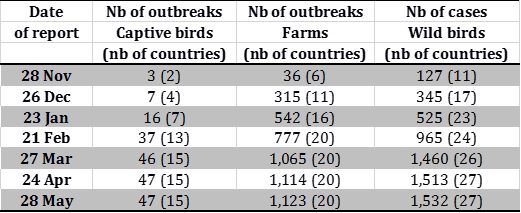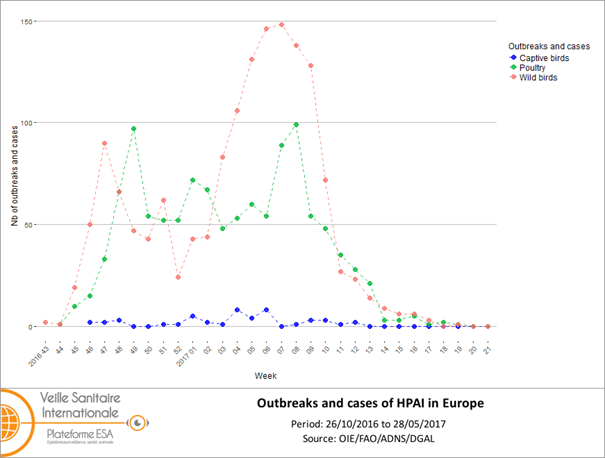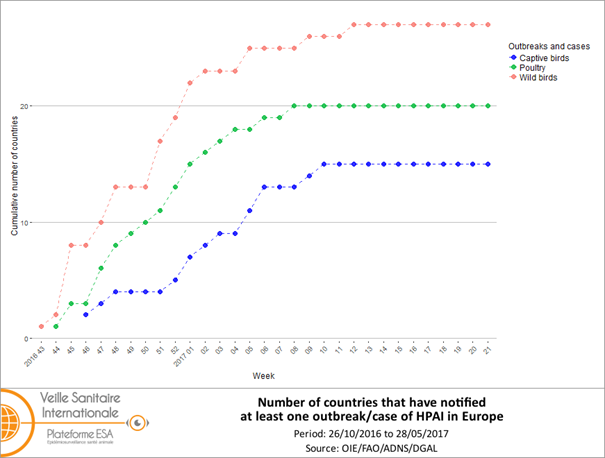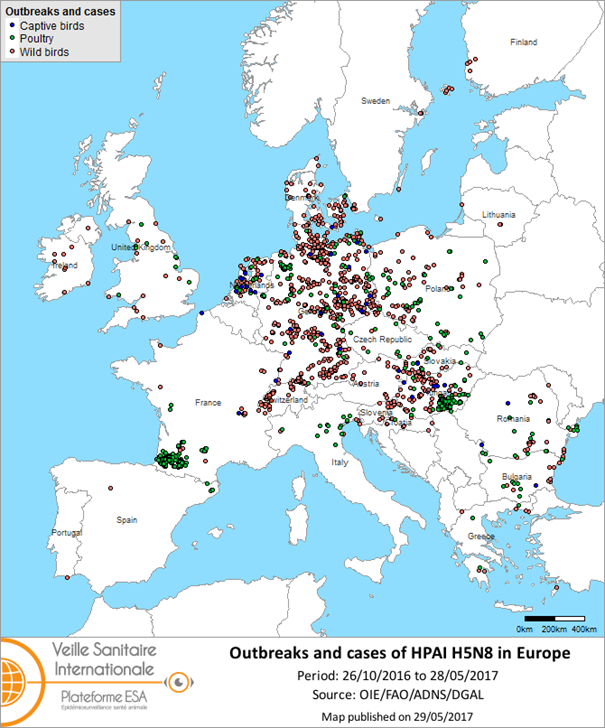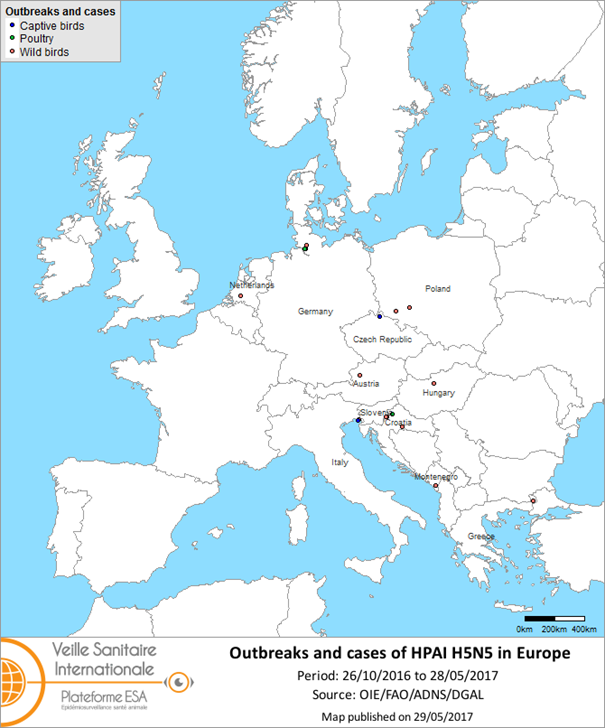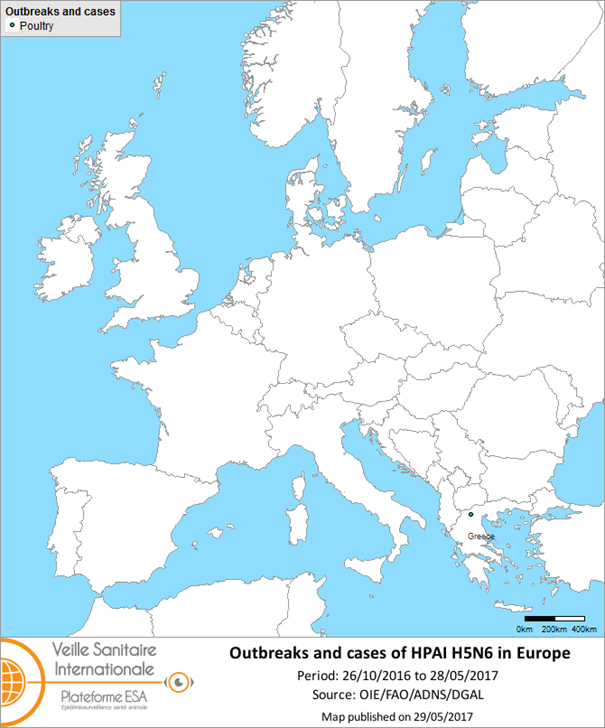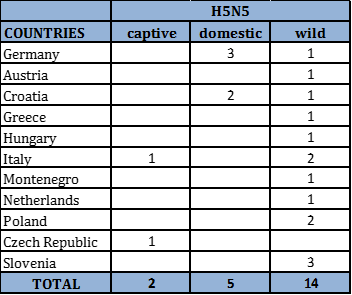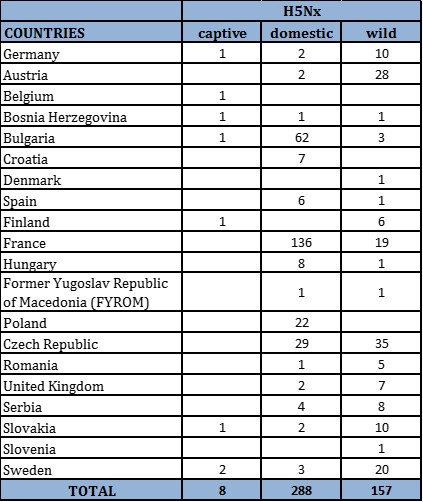Epidemiological situation of HPAI viruses from clade 2.3.4.4 in Europe since October 2016: situation as of 31st May 2017
International Animal Health Epidemic Intelligence (VSI) team – ESA Platform – France
NRL Avian Influenza, Anses laboratory Ploufragan – France
National Office for Hunting and Wildlife – France
Sources: Data updated on 28/05/2017 (included) ADNS/FAO/OIE, DGAL (General Directorate of Food – French Ministry of Agriculture)
Since the last situation report on 10th April 2017 (two weeks ago), 33 new outbreaks or cases of HPAI viruses from A/goose/Guangdong/1/1996 lineage clade 2.3.4.4 were reported in Europe (European Union – EU – and Switzerland). Since 1st April 2017, the countries that have notified an outbreak in poultry farms are Germany (last outbreak declared to ADNS on 10th May), the United-Kingdom (8th May), Sweden (25th April), Hungary (21st April), Slovakia (20th April), Italy (13th April), Romania (11th April) and Bulgaria (2nd April) (source: ADNS). The total number of outbreaks and cases of HPAI clade 2.3.4.4 reported in Europe is now 2,702 among which 1,532 in wild birds (78 species affected), 1,123 in poultry farms, and 47 in captive birds (Tables 1 & 2-5). There has been a steady decrease in the number of new outbreaks over the past two months (Figure 1).
Three related HPAI H5 viruses from clade 2.3.4.4 – H5N8, H5N5 and H5N6 – are currently circulating in Europe[1]. The ADNS tool is not adapted to the notification of new subtypes like H5N8, H5N5 or H5N6, leading countries to report the outbreaks as “H5Nx” with the possibility of mentioning the subtype in the comments section, which some countries do. Taking into account these comments, the ADNS notifications are as follows: H5Nx (n=453), H5N5 (n=21), H5N8 (n=2,227) and H5N6 (n=1). The HPAI H5 viruses in general will be analyzed in this report. This analysis takes into account modifications following first notifications that are sometimes brought to ADNS notifications, which for example might specify the subtype for some H5Nx outbreaks (which might be later notified as H5N5, H5N8 or H5N6).
Some outbreaks and cases are notified to ADNS as HPAI with no further information on the corresponding subtype (H or N), neither in the “Disease/subtype” category nor in the comments. Since October 2016, 24 outbreaks and cases of HPAI have been reported with no subtype information: one in Croatia, on in the Czech Republic, four in Belgium, six in Romania, and twelve in Serbia. These outbreaks are not included in the tables or maps of this report due to the lack of information.
Several countries have detected an HPAI H5N5 virus in wild birds (1 case in Germany, 1 in Montenegro, 2 in Italy, 1 in Croatia, 1 in Greece, 2 in Poland, 3 in Slovenia, 1 in Hungary, and 1 in Austria), in poultry farms (3 outbreaks in Germany and 2 in Croatia), and in captive birds (1 case in Italy and 1 in Czech Republic). In addition, the Netherlands reported a case of co-infection with H5N8/H5N5 in wild birds in November 2016. On 1st March 2017, Serbia reported a first case of H5N5 in a mute swan (Cygnus olor) found dead in the North of the country (source: FAO Empres-i). However, all HPAI H5 outbreaks in Serbia are reported to ADNS as “H5Nx” with no details regarding subtype. Therefore, the H5N5 outbreak in Serbia is not shown in the maps or the tables.
A new highly pathogenic avian influenza (HPAI) virus of H5N6 subtype, related to the HPAI H5 viruses from clade 2.3.4.4 currently circulating in Europe, has been detected in Greece in a poultry farm (species not mentioned) (see report from 6th March – link). This outbreak was initially declared as HP H5N8 on 16th February, and laboratory confirmation of HP H5N6 subtype was done on 2nd March.
An application enables visualization of the evolution of outbreaks and cases of HPAI in Europe through interactive map and time series, allowing users to select specific data using options and a time cursor (link).
The HP H5N8 virus is also present beyond Europe in the following countries: Israel, Egypt, Tunisia, Iran, Russia, Ukraine, Niger, Nigeria, South Korea, Chinese Taipei (commonly known as Taiwan), Uganda, Cameroon, India, Nepal, China, Kuwait, and Kazakhstan (source: OIE/FAO). A situation report of the HPAI situation in Africa as of 21st Feb 2017 is available – in French – on the ESA Platform (link).
Table 1: Evolution of number of outbreaks and cases of HPAI viruses from A/goose/Guangdong/1/1996 lineage clade 2.3.4.4 in the European Union and Switzerland and number of countries affected (in brackets) reported from 26 Oct 2016 to 28 May 2017 (included) (sources: OIE/ADNS/DGAL
Figure 1 shows the pattern of weekly notifications in Europe. The aggregated data for Europe (including Switzerland), with individual country situations varying according to surveillance and epidemiology, shows global trends. At the macroscopic scale, it is interesting to note that the “poultry” and “wild” curves show similar trends, globally parallel, with a slight delay of 2 weeks, the “wild” curve preceding the “poultry” curve. This same delay between outbreaks in wild birds and in farms is observed in the cumulated graph of the number of newly affected countries declaring their first outbreak/case of HPAI (Figure 2).
Figure 1: Number of outbreaks and cases of HPAI viruses from A/goose/Guangdong/1/1996 lineage clade 2.3.4.4 in Europe (EU, Switzerland) per week from 26 October 2016 to 28 May 2017 (included) (sources: ADNS/OIE/DGAL)
Figure 2: Cumulated weekly number of countries that have notified at least one outbreak/case of HPAI from A/goose/Guangdong/1/1996 clade 2.3.4.4 in Europe (EU, Switzerland) from 26 October 2016 to 28 May 2017 (included) (sources: ADNS/OIE/DGAL)
The pattern of these curves is coherent with a contamination of poultry farms by wild birds and seems to suggest an absence of a major evolution of the epizooty in farms, in general in the European continent (which does not exclude particular situations where there could be important localized secondary spread between farms). However, this interpretation should be nuanced as some variations could be due, on one hand, to differences in surveillance pressure depending on bird populations and, on the other, to differences among countries (as for Hungary and France which have notified a high number of outbreaks in poultry farms and much less in wild birds, compared to Germany and Switzerland which have notified a great amount of cases in wild birds but only a few outbreaks in poultry farms).
The mortality reported in farms is variable depending on the species, but also for a given species, and is calculated based on a limited number of outbreaks. For mono-species farms, the mortality varied from 0.06 to 33% in Gallus gallus farms, around 20% in turkey farms (but with a 100% mortality rate reported in an outbreak in France), and from 0 to 70% in palmipeds. Although the data must be carefully interpreted (as time of intervention in relation to infection varied, some farms are epidemiologically linked, the beginning of infection is unknown, etc.), it should be noted that this strain appears to have an unusual virulence in breeding palmipeds.
The 78 different species of birds infected in the avifauna in Europe, with their families, are:
- Accipitridae: Eagle spp, Eurasian Buzzard, Harris’s Hawk, Northern Goshawk, Rough-legged Buzzard, Sparrow Hawk, White-tailed Eagle
- Anatidae: Northern Pintail, Common Teal, Common Pochard, Tufted Duck, Common Goldeneye, Mallard, Eurasian Wigeon, Gadwall, Whooper Swan, Mute Swan, Tundra Swan, Northern Pintail, Greylag Goose, Bean Goose, Lesser White-fronted Goose, White-fronted Goose, Pink-footed Goose, Greater Scaup, Dark-bellied Brant, Canada Goose, Barnacle Goose, Red-breasted Goose, Egyptian Goose, Black Swan, Common Shelduck, Common Eider, Red-crested Pochard, Common Scoter, Common Merganser, Swan Goose, Muscovy Duck
- Ardeidae: Eurasian Bittern, Grey Heron, Great Egret, Cattle Egret
- Ciconiidae: White Stork
- Colombidae: Collared Dove, Common Wood Pigeon
- Corvidae: Eurasian Magpie, Hooded Crow, Common Raven, Carrion Crow
- Dromaiidae: Emu
- Falconidae: Peregrine Falcon, Saker Falcon, Common Krestel
- Laridae: Black-headed Gull, Herring Gull, Mew Gull, Great black-backed Gull, Yellow-legged Gull, Lesser black-backed Gull, Common Tern
- Pelecanidae: Great white Pelican, Spot-billed Pelican (Grey Pelican)
- Phalacrocoracidae: Great Cormorant, Pygmy Cormorant
- Podicipedidae: Great-crested Grebe, Little Grebe
- Psittacidae: African grey Parrot
- Rallidae: Common Moorhen, Crested Coot, Eurasian Coot
- Scolopacidae: Curlew spp, Green Sandpiper
- Strigidae: Eagle Owl, Ural Owl
- Sturnidae: Common starling
- Turdidae: Common Blackbird, Song Thrush, Fieldfare
Figure 3: Map of outbreaks and cases of HPAI H5N8 reported in the European Union and Switzerland from 26 Oct 2016 to 28 May 2017 (included) (sources: OIE/ADNS/DGAL).
Figure 4: Map of outbreaks and cases of HPAI H5N5 reported in Europe from 26 Oct 2016 to 28 May 2017 (included) (sources: OIE/ADNS/DGAL).
Figure 5: Map of outbreaks and cases of HPAI H5N6 reported in Europe from 26 Oct 2016 to 28 May 2017 (included) (sources: OIE/ADNS).
Figure 6: Map of outbreaks and cases of HPAI H5Nx reported in Europe from 26 Oct 2016 to 28 May 2017 (included) (sources: OIE/ADNS/DGAL).
Table 2: Number of outbreaks and cases of HPAI H5N8 in domestic, wild and captive birds per country and subtype in the European Union and Switzerland from 26 Oct 2016 to 28 May 2017 (included) (sources: OIE/ADNS/DGAL
Table 3: Number of outbreaks and cases of HPAI H5N5 in domestic, wild and captive birds per country and subtype in the European Union from 26 Oct 2016 to 28 May 2017 (included) (sources: OIE/ADNS/DGAL
Table 4: Number of outbreaks and cases of HPAI H5N6 in domestic, wild and captive birds per country and subtype in the European Union from 26 Oct 2016 to 28 May 2017 (included) (sources: OIE/ADNS/DGAL
Table 5: Number of outbreaks and cases of HPAI H5Nx in domestic, wild and captive birds per country and subtype in the European Union and Switzerland from 26 Oct 2016 to 28 May 2017 (included) (sources: OIE/ADNS/DGAL
References:
- The Global Consortium for H5N8 and Related Influenza Viruses 2016. Role for migratory wild birds in the global spread of avian influenza H5N8, Science, 14 Oct 2016:Vol. 354, Issue 6309, pp. 213-217. DOI: 10.1126/science.aaf8852
- H5N8 highly pathogenic avian influenza (HPAI) of clade 2.3.4.4 detected through surveillance of wild migratory birds in the Tyva Republic, the Russian Federation – potential for international spread, Empreswatch septembre 2016
- EFSA, 2014. Highly pathogenic avian influenza A subtype H5N8. EFSA Journal 2014;12(12):3941, 32 pp. doi:10.2903/j.efsa.2014.3941
Previous reports:
- “Epidemiological situation of HPAI viruses from clade 2.3.4.4 in Europe since October 2016: situation as of 24th April 2017” from 27th April (link)
- “Epidemiological situation of HPAI viruses from clade 2.3.4.4 in Europe since October 2016: situation as of 10th April 2017” from 19th April (link)
- “Epidemiological situation of HPAI viruses from clade 2.3.4.4 in Europe since October 2016: situation as of 27th March 2017” from 6th April (link)
- “Epidemiological situation of HPAI in Europe since October 2016: situation as of 13th March 2017” from 20 March 2017 (link)
- “Epidemiological situation of HPAI in Europe since October 2016: situation as of 27th February 2017” from 07 March 2017 (link)
- “Epidemiological situation of HPAI in Europe since October 2016: situation as of 20th February 2017” from 22 Feb 2017 (link)
- “Epidemiological situation of HPAI in Europe since October 2016: situation as of 8th February 2017” from 13 Feb 2017 (link)
- “Epidemiological situation of HPAI in Europe since October 2016: situation as of 16th January 2017” from 20 Jan 2017 (link)
- “Epidemiological situation of HPAI in Europe since October 2016: situation as of 9th January 2017” from 11 Jan 2017 (link)
- “Epidemiological situation of HPAI H5 in Europe since October 2016: situation as of 2nd January 2017” from 04 Jan 2017 (link)
- “Epidemiological situation of HPAI H5N8 in Europe since October 2016: situation as of 19th Dec 2016” from 21 Dec 2016 (link)
[1] Another HPAI H5 virus, H5N1, has been sporadically identified in France, with a new outbreak declared on 21st March 2017 in a duck farm in the Southwest of France. This HP H5N1 virus is related to French HP strains detected in winter 2015-2016 and in summer 2016, but is not related to the Asian lineage A/goose/Guangdong/1/1996 clade 2.3.4.4 (which includes HP H5N8, H5N5 and H5N6 viruses currently circulating in Europe). This outbreak is, therefore, not mentioned in this report which concerns only clade 2.3.4.4 viruses, but is presented in the HPAI situation report for France published on 3rd April 2017 (link).

